Craving a comforting, flavor-packed meal that’s both healthy and incredibly quick to prepare? Look no further than this delightful Japanese Udon Noodle Soup with Miso. It’s the ultimate fast food, Japanese style, perfectly suited for busy students, on-the-go parents, or anyone seeking a delicious and nourishing meal without the fuss.
From start to finish, this vibrant Udon Noodle Soup with Miso can be on your table in less than 15 minutes, making it an ideal addition to your repertoire of quick and easy meals. It’s light, wholesome, and bursting with umami goodness.
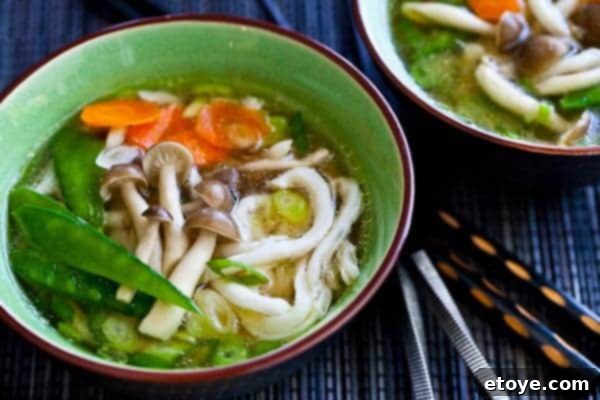
Why This Quick Udon Noodle Soup is a Must-Try
This Japanese Udon Noodle Soup isn’t just fast; it’s a triumph of flavor and simplicity. Here’s why it deserves a spot in your weekly meal rotation:
- **Rich and Savory Flavor Profile:** The addition of high-quality miso paste infuses the broth with a profound umami depth, creating a savory, deeply satisfying soup that will tantalize your taste buds.
- **Effortlessly Easy Preparation:** With just a handful of staple ingredients, this udon noodle soup recipe comes together in under 15 minutes, proving that gourmet flavors don’t require hours in the kitchen. It’s perfect for beginner cooks and seasoned chefs alike.
- **A Noodle Lover’s Dream:** For anyone who adores the chewy, comforting texture of noodles, this dish delivers. The thick udon noodles perfectly absorb the rich miso broth, making every bite a delight.
- **Packed with Wholesome Goodness:** Loaded with a colorful array of fresh vegetables, this soup is a fantastic way to boost your daily nutrient intake. It’s a nourishing meal that leaves you feeling satisfied and energized.
- **Highly Customizable:** Easily adapt this recipe to suit your preferences or what you have on hand. Swap vegetables, add a protein, or adjust the spiciness – the possibilities are endless.
Essential Ingredients for Your Miso Udon Noodle Soup
Creating this delicious soup requires only a few key components. The beauty lies in the quality and freshness of these simple ingredients:
- **Udon Noodles:** These thick, chewy wheat noodles are the star of the dish. You can opt for fresh, dried, or frozen varieties.
- **Vegetable or Chicken Stock:** The base of your soup. A low-sodium option is recommended to control the overall saltiness, especially with the addition of miso.
- **Fresh, Crisp Vegetables:** Carrots, snow peas, mushrooms (like shimeji or shiitake), and vibrant green onions not only add essential nutrients but also contribute delightful textures and colors.
- **White Miso Paste (Shiro Miso):** The secret to the soup’s incredible savory flavor. Shiro miso is milder and slightly sweet, making it perfect for a balanced broth.
Crafting Your Perfect Udon Noodle Soup: A Step-by-Step Guide
Follow these simple steps to create a warm, inviting bowl of Japanese Udon Noodle Soup with Miso in minutes:
- **Prepare the Udon Noodles:** Begin by cooking your udon noodles according to the package instructions. This usually involves boiling them in water for a few minutes until they are tender yet still possess their characteristic chewiness. Once cooked, drain them thoroughly and set them aside. Rinsing them lightly with cold water can prevent them from sticking together if you’re not adding them to the soup immediately.
- **Simmer the Broth and Vegetables:** While the noodles are cooking, take a medium-sized pot and bring your chosen stock (vegetable or chicken) to a rolling boil. Once boiling, reduce the heat to medium. Add the thinly sliced carrots to the simmering stock and cook them for 1-2 minutes until they are crisp-tender, retaining a slight bite. Next, introduce the mushrooms and snow peas, cooking for approximately 1 minute. You want them to soften slightly but remain bright green and vibrant. Overcooking will diminish their texture and fresh flavor.
- **Incorporate the Miso and Assemble:** In a separate medium bowl, place the white miso paste. Ladle a small amount of the hot broth from your pot into the bowl with the miso. Whisk vigorously until the miso paste is completely dissolved and forms a smooth, lump-free mixture. This tempering step is crucial. Gently pour this dissolved miso mixture back into the pot with the soup. **Important:** Do not bring the soup to a boil once the miso has been added, as high heat can cause the miso to lose its delicate flavor and turn gritty. Finally, stir in the cooked udon noodles and the chopped green onions. Heat gently for another minute to ensure everything is warmed through. Serve immediately and savor the fresh, savory flavors.
Exploring the World of Japanese Udon Noodles
Udon noodles are a cornerstone of Japanese cuisine, known for their distinct white color, considerable thickness, and delightful chewiness. Made primarily from wheat flour, these versatile noodles come in various forms, each offering a slightly different culinary experience. While traditionally made with wheat, for those following low-carb or gluten-free diets, alternatives like Shirataki Noodles can be an excellent substitute, providing a similar texture without the gluten or high carbohydrate count.
Dried Udon Noodles: The Pantry Staple
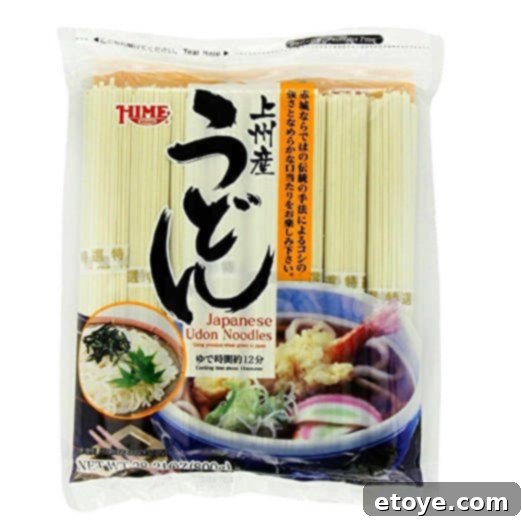
Dried udon noodles are the most common and accessible form, readily available in the Asian section of most major grocery stores. They are an excellent pantry staple for quick meals. When cooking dried udon, there’s no need to salt the boiling water. Most Asian-style noodles, including udon, already contain salt in their composition, making additional seasoning unnecessary. A popular and reliable brand for dried udon is Hime, known for its consistent quality. You can often find them on Amazon for a convenient purchase.
Fresh, Prepared Udon Noodles: A Chewier Delight

For an even more authentic and satisfying experience, fresh, prepared udon noodles are an excellent choice. These noodles are typically thicker, wonderfully chewy, and incredibly delicious. Since they are already cooked, their preparation is incredibly fast – usually requiring just a minute or so of boiling to warm them through. Always refer to the specific package instructions, as cooking times can vary slightly between brands.
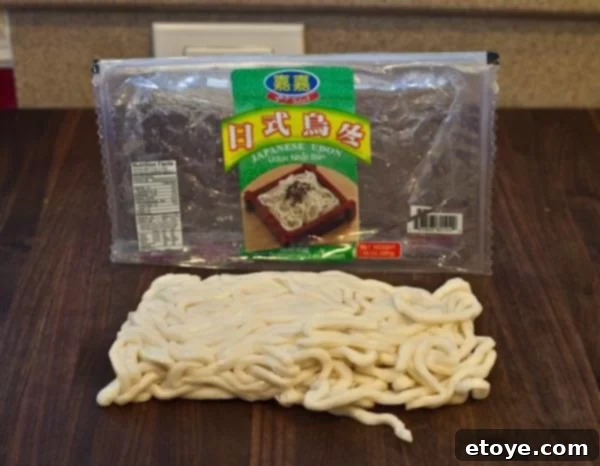
Making Udon Noodles From Scratch: The Artisan’s Path
For the adventurous cook, making udon noodles from scratch is a rewarding endeavor. It offers a unique texture and flavor that store-bought noodles can’t quite match. If you’re interested in mastering the art of homemade udon, acclaimed Iron Chef Morimoto has generously shared his recipe, allowing you to create truly exceptional noodles right in your own kitchen.
The Magic of Miso Paste in Udon Noodle Soup
The distinctive, deeply savory flavor of this udon noodle soup largely comes from the addition of miso paste. Miso is a traditional Japanese seasoning produced by fermenting soybeans with salt and kōji (a type of fungus), and often rice, barley, or other grains. It’s a foundational ingredient in Japanese miso soup and many other dishes.
Miso is an excellent staple to keep in your refrigerator, as it boasts a long shelf life of about six months and can be used in countless recipes, from marinades and dressings to glazes and, of course, soups. For this Udon Noodle Soup, I highly recommend using Shiro Miso, also known as White Miso.
Shiro miso is characterized by its light color, slightly sweet taste, and mild umami flavor. It’s fermented for a shorter period and with a higher proportion of rice kōji compared to soybeans, resulting in a less salty and intense flavor profile than red miso (aka miso) or yellow miso (shinsu miso). This makes shiro miso ideal for a delicate yet flavorful broth that won’t overpower the other ingredients in your udon soup.
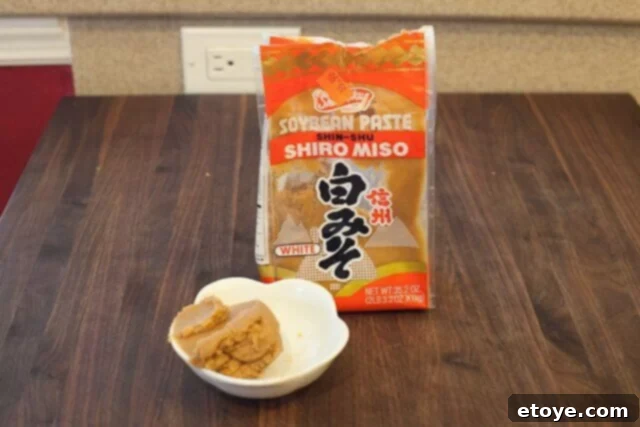
Optimizing Vegetables for Udon Noodle Soup
The beauty of this udon noodle soup recipe is its flexibility when it comes to vegetables. While our core recipe includes carrots, snow peas, mushrooms, and green onions, you can truly make it your own by adding your favorite seasonal produce. I often use shimeji mushrooms (also known as white beech mushrooms) for their incredibly healthy properties and their unique, slightly slippery texture that adds an interesting dimension to the soup. You can find more information about them at Hokto Kinoko.
The key to quick cooking and a harmonious bowl is to slice all your vegetables thinly. For example, carrots are best sliced into thin coins or julienned strips so they cook rapidly, becoming crisp-tender in just a few minutes. Here are some other fantastic vegetable additions and garnishes you might consider:
- **Snow Peas:** Sliced on the diagonal for visual appeal and quick cooking.
- **Carrots:** Thinly sliced or pre-cut julienne carrots for convenience.
- **Fresh Mushrooms:** Beyond shimeji, consider sliced shiitake for an earthy flavor, or even regular white button mushrooms.
- **Corn Kernels:** Adds a touch of sweetness and vibrant yellow.
- **Hard-Boiled Egg:** A classic topping, simply sliced in half.
- **Thin, Roasted Seaweed Slices (Nori):** Adds a delicate oceanic flavor and crispy texture.
- **Fresh Bean Sprouts:** For a refreshing crunch.
- **Spinach:** Wilted into the hot soup just before serving for added greens.
- **Daikon Sprouts:** A peppery garnish that adds a subtle kick.
- **Fresh Tomato Slices:** For a hint of acidity and color.
Feel free to experiment with bell peppers, thinly sliced zucchini, or even small broccoli florets. The goal is to choose vegetables that cook quickly and complement the rich miso broth.
Video Guide: How to Make Udon Noodle Soup
Visual learners, rejoice! Watch this helpful video demonstration to see just how easy it is to create this delicious Udon Noodle Soup with Miso. Follow along with each step to ensure perfect results every time.
Expert Tips for the Best Udon Noodle Soup
Enhance your Udon Noodle Soup experience with these invaluable tips and tricks:
- **Noodle Alternatives:** If udon noodles aren’t available, don’t let that stop you! You can easily substitute them with other pasta noodles like fettuccine or even ramen noodles (without the seasoning packet) for a similar comforting effect.
- **Consistent Vegetable Prep:** Always aim to slice your vegetables thinly and uniformly. This ensures they cook evenly and quickly, preventing some from being undercooked while others turn mushy.
- **Miso Management is Key:** As mentioned, shiro miso (white miso) is generally the least salty and most balanced choice for this soup. If you opt for a different type, such as yellow or red miso, which are more potent and salty, consider reducing the amount by a teaspoon or two to avoid an overly strong or salty flavor. Taste and adjust!
- **Never Boil Miso:** This is a golden rule in Japanese cooking. Boiling miso will destroy its delicate enzymes, diminish its nuanced flavor, and can result in a grainy texture. Always stir miso into the soup after it’s removed from direct heat or has been brought down to a gentle simmer.
- **Add Your Favorite Protein:** This soup is wonderfully versatile. Feel free to incorporate your protein of choice to make it even heartier. Sliced cooked chicken, thin strips of beef, shrimp, or even cubes of tofu are excellent additions. Just ensure any meat or seafood is thoroughly cooked before adding it to the soup.
- **Optimal Storage:** Any leftover miso udon noodle soup can be stored in an airtight container in the refrigerator for 2-3 days. For best results, store noodles separately from the broth if possible, as they can absorb too much liquid and become soggy. Reheat gently on the stovetop or in the microwave.
- **Garnish for Impact:** Don’t forget the garnishes! A sprinkle of toasted sesame seeds, a drizzle of sesame oil, a dash of togarashi (Japanese chili pepper blend), or extra fresh green onions can elevate both the flavor and presentation.
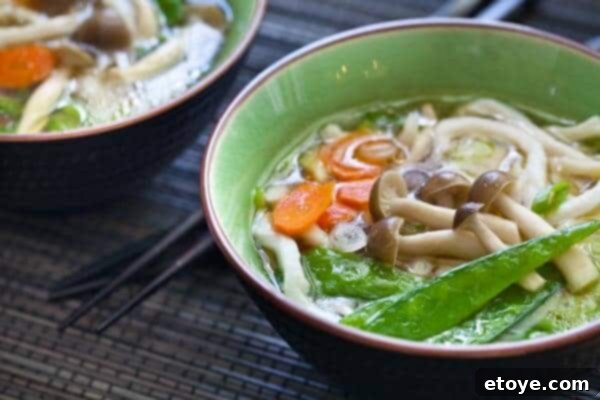
Discover More Delicious Recipes Using Miso Paste
Miso paste is a versatile ingredient that adds incredible depth to a variety of dishes. If you’ve enjoyed this udon noodle soup, you’ll love exploring these other recipes that feature miso:
- Miso Salmon
- Miso Almond Sauce (fantastic as a dressing, dipping sauce, or tossed with noodles)
- Chicken Salad with Sesame Miso Dressing
- Miso Butter Shrimp Appetizer
- Rachael’s Gyoza
- Japanese Noodles with Shimeji Mushroom
- Grilled Miso Tenderloin
- Sake Miso Marinated Butterfish
We hope you enjoy making and savoring this incredible Udon Noodle Soup with Miso recipe. It’s a truly satisfying dish that brings the authentic flavors of Japan right to your kitchen. Have you tried this recipe? We’d love to hear your thoughts! Please feel free to leave a star rating and share your experience in the comments section below!
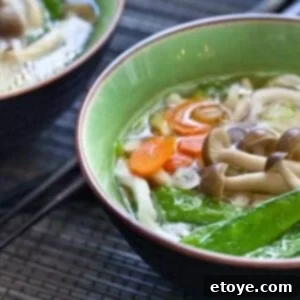
Udon Noodle Soup Recipe with Miso
Jaden
Pin Recipe
Ingredients
- 12 ounce udon noodles
- 6 cups prepared low sodium vegetable stock or chicken stock
- 1/2 cup thinly sliced carrots
- 1/2 cup snow peas sliced on the diagonal
- 1 cup fresh mushrooms sliced
- 2 tablespoons white miso paste
- 2 green onions chopped
Instructions
- Cook the udon noodles according to the package directions, drain and set aside.
- In the meantime, in a medium pot, bring the stock to a boil. Lower the heat to medium and add the carrots and cook until the carrots are crisp-tender, 1 to 2 minutes. Add the mushrooms and snow peas and cook until slightly tender but still bright green, about 1 minute.
- In a medium bowl, add the miso paste. Add a ladleful of hot broth. Whisk until the miso is completely dissolved, then pour the entire miso mixture into the pot with the soup. Do not boil the soup with the miso, as the miso will become gritty. Stir in the noodles and the green onions.
